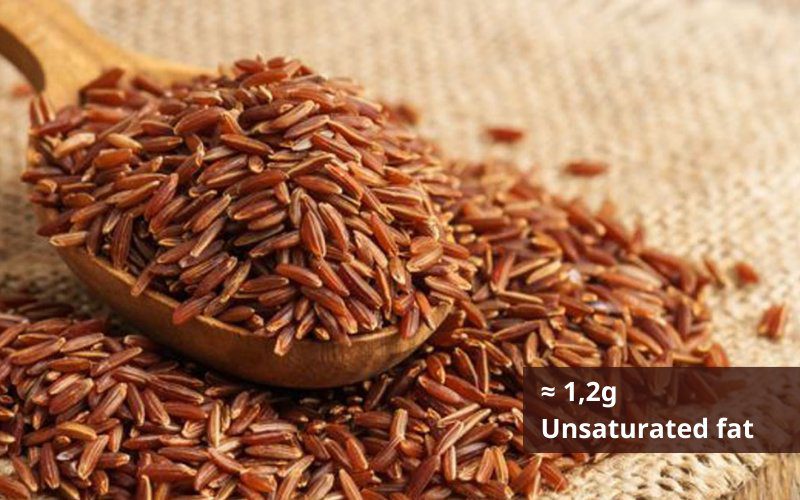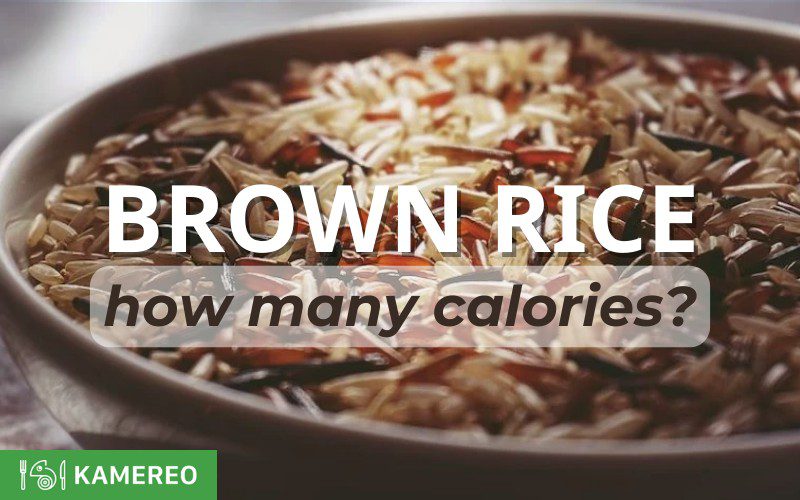Brown rice is commonly known as a healthy food, offering many health benefits. However, do you know how many calories in brown rice? This is crucial for those following a diet regimen. Let’s explore the calorie content in brown rice through the following article!

How Many Calories in Brown Rice?
The calorie content in brown rice varies depending on different types of rice. Additionally, the method of preparation also contributes to changing the calorie intake.
How Many Calories in 100g of Brown Rice?
How many calories in brown rice? The calorie content in brown rice is quite comparable to white rice that we consume daily. Accordingly, 100g of brown rice contains about 110.9 kcal, while 100g of white rice typically contains 130 kcal. The difference in calorie content between various types of brown rice is not significant.

How Many Calories in a Bowl of Brown Rice?
A bowl of brown rice weighing about 195g contains approximately 218 kcal and has the following nutritional components:
- Energy (Carbs): 45.8g.
- Protein: 4.5g.
- Fat: 1.6g.
Read more: Guide on two ways to cook nutritious brown rice for a healthy meal
Nutritional Components in Brown Rice
Although brown rice is not calorie-dense, it provides many essential nutrients to the body. This helps you easily control the energy your body absorbs while still getting enough nutrients. Here are the nutritional components in brown rice:
Starch
A portion of brown rice contains about 45g of complex carbohydrates, including 42.4g of starch and 3.5g of fiber. This compound provides more nutrition than simple carbohydrates (sugars) because it contains both fiber and other nutrients. Therefore, regularly consuming brown rice is beneficial for overall health.

Protein
A bowl of brown rice provides over 4g of plant-based protein. However, like many other grains, this protein is incomplete. In simple terms, plant protein lacks some essential amino acids compared to animal protein sources.
Fat
Although it does not contain unhealthy fats, a serving of brown rice only contains about 1.2g of unsaturated fat. This compound is also known as healthy fat, helping increase good cholesterol levels while reducing bad cholesterol in the blood and maintaining heart health.

Vitamins and Minerals
Brown rice undergoes minimal processing, so it retains most vitamins and minerals. These substances often contain many nutrients with high biological value. Accordingly, brown rice contains B-group vitamins including: vitamins B1, B3, B5, B6, along with minerals such as manganese, selenium, magnesium, zinc, and antioxidants.
Health Benefits of Brown Rice
With the above nutritional values, brown rice has many positive effects on human health. Below are some impacts you can consider:
Providing Energy
Brown rice provides all three major nutrients needed to supply energy to the body, including: carbohydrates, protein, and fat. Most of the energy in brown rice comes from carbohydrates in the form of starch. Therefore, like white rice, brown rice can be used as a primary energy source for everyday human activities effectively.

Providing Healthy Fiber
Brown rice is a good source of fiber for the body. Accordingly, a bowl of brown rice can provide about 13% of your daily fiber needs. A fiber-rich diet can help control weight, support digestion, maintain stable blood sugar levels, and provide many other benefits.
Reducing the Risk of Heart Disease
Brown rice contains lignans – a type of plant compound commonly found in whole grains. Accordingly, this compound acts as an antioxidant. Moreover, lignans have been studied to reduce blood pressure, cholesterol, and help reduce arterial stiffness. These are all risk factors for dangerous chronic cardiovascular diseases.

Rich in Beneficial Plant Compounds
In addition to vitamins and minerals, brown rice also contains many phytochemicals including: phenolic acids, flavonoids, tannins, anthocyanins, etc. These are plant compounds that provide many health benefits such as: boosting the immune system, antioxidant, anti-inflammatory, anti-allergic, and cancer prevention.
Preventing Anemia
Brown rice is a rich source of minerals such as iron, phosphorus, magnesium, potassium, zinc, and copper. Both the content and quantity of these minerals in brown rice are significantly higher than in white rice. Particularly, brown rice is also the food with the highest iron content among all types of rice. This helps enhance overall health and prevent anemia in people who regularly consume brown rice.

Reducing the Risk of Diabetes
Replacing refined grains like white rice with brown rice can better control blood sugar levels. Therefore, the risk of developing diabetes is also significantly reduced.
Moreover, studies have also shown that consuming whole grains such as brown rice can effectively reduce the risk of type 2 diabetes by up to 32%.
Does Eating Brown Rice Help with Weight Loss?
Brown rice is a whole grain cereal with a higher fiber content than white rice. This compound helps extend the feeling of fullness after eating, while controlling feelings of hunger and cravings. Therefore, the amount of calories absorbed by the body decreases. This helps you manage weight in a healthy way.
To lose weight healthily, it’s important to combine eating brown rice with a variety of other foods in appropriate proportions. Thus, this diet ensures that the body still absorbs enough nutrients but does not gain weight.

Should You Eat Brown Rice Every Day?
We all know that brown rice is more nutritious than white rice. However, you should not replace white rice with this type of rice in your daily diet.
The main reason is that brown rice is harder to digest than white rice, so consuming too much can cause digestive issues such as bloating and indigestion. Consider combining brown rice with other grains to supplement nutrients without affecting digestion.

Who Should Eat Brown Rice?
Although brown rice has many positive effects on the body, not everyone can eat brown rice. Below are some people who should prioritize eating rice made from this type of rice:
People who want to lose weight
Brown rice is rich in fiber, helping you feel full quickly and prolonging the feeling of fullness. Therefore, those who want to lose weight should choose to consume brown rice more regularly. This supports controlling food and calorie intake more effectively.
Cardiovascular patients
The antioxidants in brown rice are valuable nutrients that benefit heart health. In addition, the high fiber and magnesium content in this type of rice have been shown to reduce blood pressure and cholesterol. Therefore, the risk of death for people with cardiovascular disease is significantly reduced.

Diabetic patients
Brown rice has an average GI index of 55, falling into the group of low glycemic index foods. This means that after eating, brown rice does not cause a sudden increase in blood sugar. Therefore, consuming brown rice helps maintain stable blood sugar levels, especially for people with diabetes.
Brown Rice Allergy
Although brown rice provides many essential nutrients, it still has the potential to cause allergies due to containing a small amount of arsenic. If you absorb too much of this substance for a long time, it can cause many dangerous complications such as: kidney, lung cancer, and skin damage due to keratosis.
Therefore, when buying brown rice, choose reputable brands and make sure that the water source used to cook brown rice is not contaminated to minimize the risk of arsenic allergies.
Read more: Who should avoid drinking toasted brown rice water?

How to Store Brown Rice
Brown rice is a dry food that is easy to store. Accordingly, you only need to place the rice in a jar, container, or airtight box, then store it in a dry and cool place. However, check the rice regularly for mold, insects, and deal with them promptly. This helps you protect the quality of rice for a long time.

Conclusion
How many calories in brown rice? Through the article, you must have the answer to this question. Ignoring the insignificant differences between various types of brown rice, 100g of brown rice provides about 110.9 kcal. This is an excellent choice for those who want to lose weight, cardiovascular patients, and diabetic patients looking to improve their health. Finally, follow the Health and Beauty section for more interesting and useful information!
Read more:



